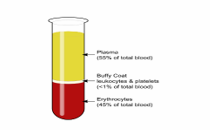Combining Experience, Advanced Diagnostic Methods
and Collaborative Treatment Procedures
What is Platelet Rich Plasma (PRP)?
Although blood is mainly a liquid (called plasma), it also contains small solid components (red cells, white cells, and platelets.) The platelets are best known for their importance in clotting blood. However, platelets also contain hundreds of proteins called growth factors which are very important in the healing of injuries.
PRP is plasma with 5 to 10 times more platelets than what is typically found in your circulating blood and the 6 most important major growth factors: Epidermal growth factor, collagen stimulating growth factor, transforming growth factor, platelet derived growth factor, vascular endothelial growth factor and fibroblast growth factor.
 Why get PRP injections?
Why get PRP injections?
PRP can be very effective in treating osteoarthritis, especially in the earlier stages. With age, the cartilage lining the joints can shrink and wear thin causing friction between the bones. Growths called bone spurs and inflammation can gradually enlarge the joint leading to the pain and dysfunction of arthritis. PRP can help reduce this inflammation and pain. It may also be able to stimulate cartilage regeneration, which could potentially inhibit the deteriorating effects of age and slow the progression of arthritis.
PRP presents patients with a long lasting, permanent solution that will not wear off over time as with a traditional pain injection. For this reason, the use of PRP could help a patient avoid joint replacement surgery, and potentially back surgery. With any treatment option, the effectiveness of the treatment depends upon the severity of the injury.
At Bellevue Pain Institute, PRP injections can be given with or without our clinics adjunct therapies which include Cervical/ Lumbar decompression, Hot laser therapy, Neuropathy treatments, Chiropractic care and Physical Therapy.
Platelet rich plasma injections are most effective for:
- Lumbar spine disc pain
- Rotator Cuff injuries

- Shoulder pain
- Tennis/ golfer’s elbow (FDA approved)
- Hip strains
- Knee sprains
- Patellar tendonitis
- Achilles tendonitis
- Plantar fasciitis
- Neuropathy
- Sacroiliac joint pain
- Cervical spine disc pain
What to expect during your procedure
- First, blood is drawn from your arm and placed in a tube. The tube is put in a centrifuge (spinning machine) for 10-15 minutes. This spinning concentrates the platelets and removes some of the cells that are not needed for this treatment. The result is PRP.
- The skin over your injured tendon or painful joint is treated with a numbing medicine.
- The PRP is then injected into your area/s of concern. You may feel some pain during the injection. The level of pain varies from person to person.
- Ultrasound may be used during this procedure to help the doctor inject the PRP in the right place.
- The entire procedure usually takes about 45 to 60 minutes.
PRP Site Care
- Keep the PRP site clean and dry.
- You may remove your band-aids 12 hours after the procedure.
- You may shower 12 hours after the procedure.
- DO NOT use ice on the PRP site because ice reduces swelling. The therapy is meant to encourage inflammation, which helps you heal.
- You may have some swelling and bruising for three to seven days.
How long will it take to feel the effects of PRP?
PRP therapy takes time to work. You may feel more pain initially after the procedure because we are causing more swelling to an already sore site. The swelling actually helps heal your affected sites by stimulating growth factors and promoting wound healing. Please be patient through this process. PRP healing can take up to 6 weeks to show any effect. It may take more than one injection to heal your affected area. You will discuss your condition with Dr. Newton and develop a plan that is right for you.
Possible Side Effects
Since PRP is derived from your own blood, there is virtually no risk of rejection or allergic reactions. However, because PRP stimulates swelling and inflammation that will help repair and heal your area of concern you may experience:
- Pain at the injection site
- Pain in the injected joint that can last up to 3-7 days
Very rare side effects that can occur:
- Infection at the injection site
- Nerve damage at site
- Tissue damage
- Nausea
OrthoBiologic procedures include:


